I like Ultraman a lot // some other stuff too // main blog to @siberianprototype
Don't wanna be here? Send us removal request.
Text
i love the phrase "sex pervert" like. as opposed to what? abstinence pervert?
38K notes
·
View notes
Text
Was at the art museum earlier and i have a new favourite painting
123K notes
·
View notes
Text



get twinsie'd, idiot
#lukeeeeee#crossing my fingers that the tales announcement bandai's making this month includes abyss news#tales of the abyss#TOA
145 notes
·
View notes
Photo


She thinks we can’t see her.
328K notes
·
View notes
Text
Oh btw I'm reading another star trek novel and chapter 1 just opens like this

26K notes
·
View notes
Text
every time i see someone call kirk and spock the oldest ship, i'm filled with the urge to go "hmm actually the holmes and watson girlies have been here for a hundred years now", and i refrain because i know the natural conclusion of this game is gilgamesh and enkidu
64K notes
·
View notes
Text

YouTube is implementing an AI policy that tracks your watch history and determines your age with it. The only way to be able to continue watching the videos you want on YouTube if you've been falsley flagged as a minor by their AI is to give YouTube your government ID. This is being implemented in the US right now. It is essential to rage against this and put YouTube in the fucking ground if they continue with it—that may be the only way to make them backtrack. But damn isn't that hard to do when responding to this announcement with a polite but negative comment flags you for violating community guidelines and bans you from even posting it?
25K notes
·
View notes
Text
Had my suspicions but I have finally confirmed it this morning: The rival Pokémon Go team I have been beefing with, whose gym's total annihilation I have incorporated into my morning routine, is actually a group of local elementary school students
43K notes
·
View notes
Text



















Artist Yudori musing on queer expression and queerness in fiction, diverging by cultural perception. [originally posted on instagram]
20K notes
·
View notes
Text
never possess me i have no self worth and have carried an indefinable guilt in my soul for as long as i can remember i'll just implicate us both in something horrific and irreparable
1K notes
·
View notes
Text
Incantation Bowls from Mesopotamia, c.300-700 CE: these bowls are lined with Aramaic incantations and drawings that show demons being shackled and subdued; they were often buried beneath houses and cemeteries in an effort to capture malevolent spirits
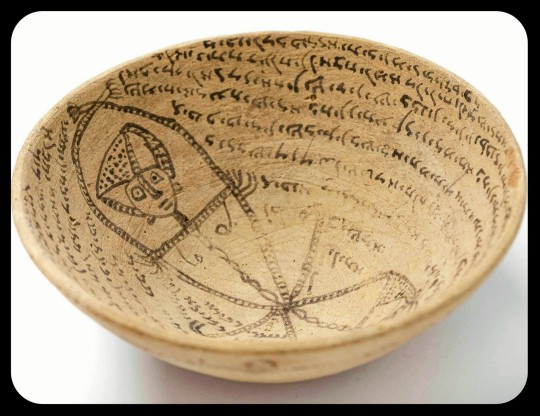
Bowls like this were once produced as magical amulets in parts of Mesopotamia (in what is now Iraq and Iran). As this article explains:
Thousands of similar incantation bowls, also known as magic bowls, were produced in the area of today’s Iraq between the fifth and eighth centuries. Clients used incantation bowls to protect and heal, to frighten off demons and evil spirits, and, in a few cases, to enlist demons to help secure love or money, or to harm adversaries. In addition to the magical texts, scribes sketched drawings of bound and chained demons – pictorial representations of the spells’ desired effect – on the bottom of about a quarter of the bowls.
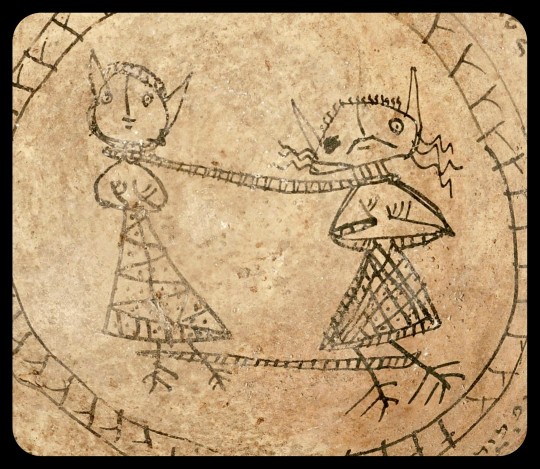
Above: this incantation bowl was commissioned by someone named Gia Bar Imma nearly 1,700 years ago, and it features a Jewish Babylonian Aramaic inscription along with a drawing of two demons wrapped in chains
These bowls were created and used by people of many different faiths. They were typically inscribed with Aramaic text, which appeared in one of three different dialects: Jewish Babylonian Aramaic, Mandaic, or Syriac. Incantations that were written in Jewish Babylonian Aramaic are, of course, attributed to Jewish communities, but the ones in Mandaic are associated with Gnostic Mandaeans, and the ones in Syriac are typically associated with Christians, Manichaeans, or followers of the ancient Babylonian religion.

Above: this bowl is lined with an Aramaic inscription that invokes "the powers of Enoch, the seven planets, and the twelve signs of the zodiac" to protect the home of a man named Pabak bar Kufithai
There are a few incantation bowls that feature Arabic or Persian inscriptions instead, and those examples tend to have Islamic or Zoroastrian motifs. Some bowls are simply inscribed with gibberish:
The largest number of known incantation bowls are written not in Syriac, but in Jewish Aramaic by Jewish scribes (though not necessarily for Jewish clients). Mandaean bowls are the second most numerous, only then followed by bowls in Syriac. A handful of bowls in Arabic and Persian are also known, in addition to bowls – perhaps 10 per cent – that can only be called ancient forgeries. These latter are filled with scribbles that mimic cursive writing but are not, in fact, in any language at all; perhaps they were made by illiterate scribes preying on equally illiterate clients.
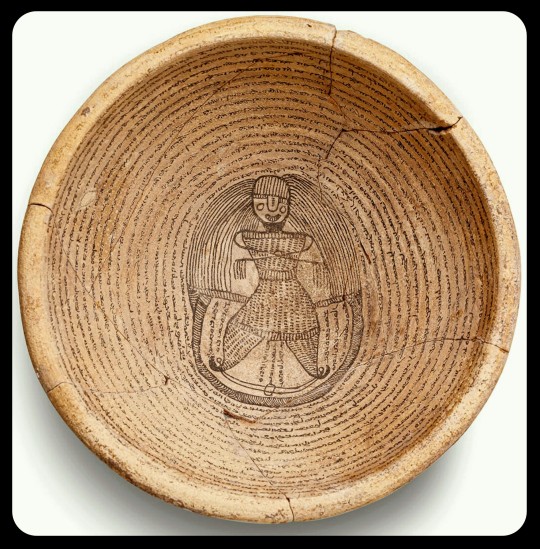
Above: this bowl features a Mandaic inscription
Incantation bowls provide valuable information about Jewish history, in particular:
The prevalence of Jewish Aramaic bowls are what makes these artefacts so important for Jewish history. They provide the sole piece of epigraphic evidence documenting Jewish language and religion at one of the most important times in Jewish history: the period of the composition of the Babylonian Talmud.
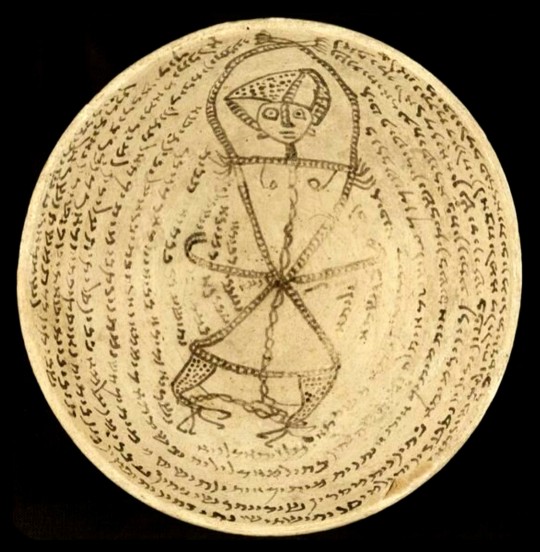
Above: researchers believe that the figure in the center of this bowl is a representation of the demon Lilith, whose likeness and/or name appears on many other incantation bowls
This article also notes:
Generally speaking, the incantations could do a number of things: healing fevers and diseases; guarding from sudden death, injustice, and treachery; and exorcising evil spirits. Similar metal talismans were made around the same time and filled largely the same role. Where they differ is that in many instances the bowls called upon deities or angels to ensnare demons. It is believed from drawings on incantation bowls depicting ensnared creatures that the reason that so many have been found upside-down is that they were intended to be traps for careless or curious demons.
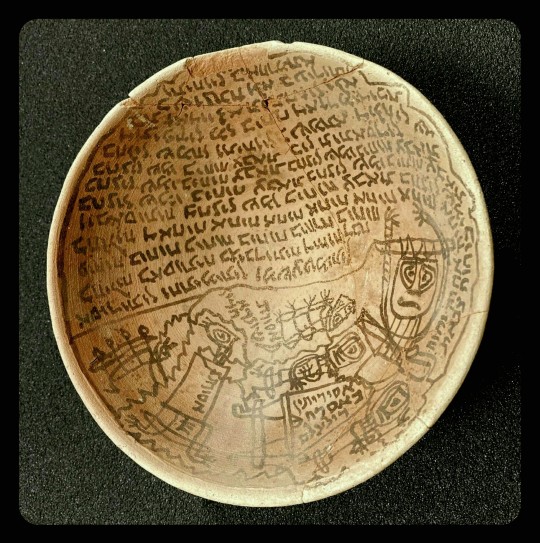
Above: this bowl has a Jewish Babylonian Aramaic inscription that includes the phrase "this cat is bound," and it features a drawing of a demonic cat being restrained
More than 2,000 of these bowls are known to exist, but only a fraction of them have been thoroughly studied.
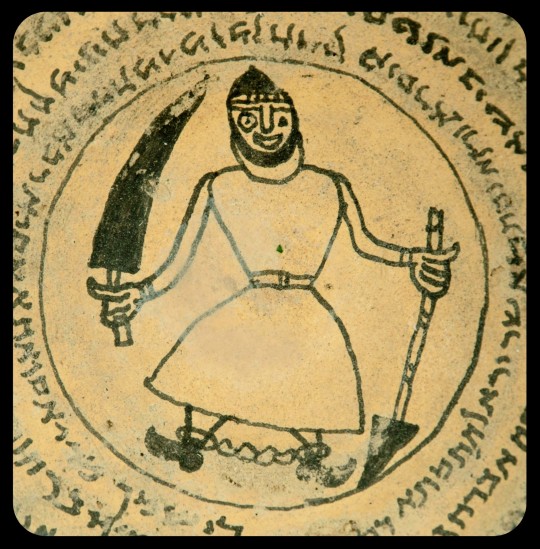
Above: an illustration from another bowl
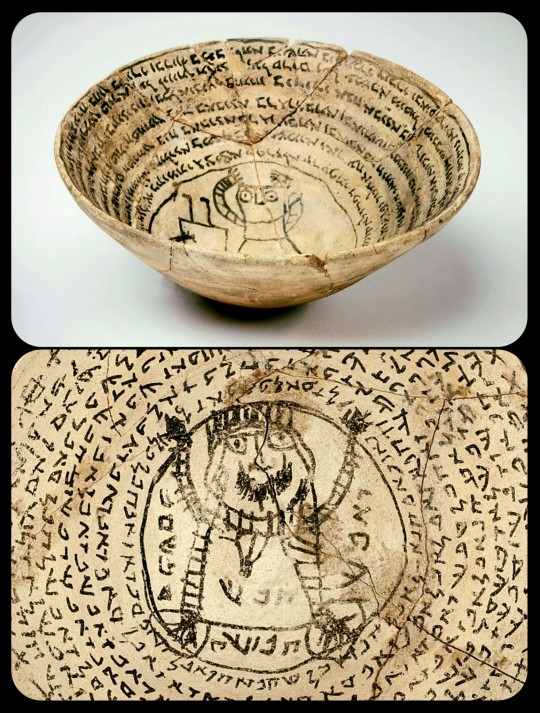
Above: two incantation bowls with Jewish Babylonian Aramaic text and drawings that show demons being restrained
Sources & More Info:
Aeon: Magic Bowls of Antiquity
Penn Today: The Stories the Bowls Tell
Bowers Museum: To Catch a Demon: Mesopotamian Incantation Bowls
Jewish Quarterly Review: Magic Formulae and Women's History: Authorship, Agency, and Gender in the Aramaic Incantation Bowls
My Jewish Learning: Magic Bowls
The Librarians: Who Wrote these Ancient Jewish Incantation Bowls?
Penn Museum: Hebrew Bowl
Journal of Late Antiquity: Enslaved People and the Demonic in the Sasanian Empire
1K notes
·
View notes
Text
what if your doppelganger loved being you more than you ever loved being yourself. they're better at being you and everyone loves them and it feels almost selfish to want your life back. i want clone horror but the horror is that the thing trying to replace you is also the person you always wanted to be.
59K notes
·
View notes
Text
gooodbyee 200 dollars helloo piece of pleastic
60K notes
·
View notes


